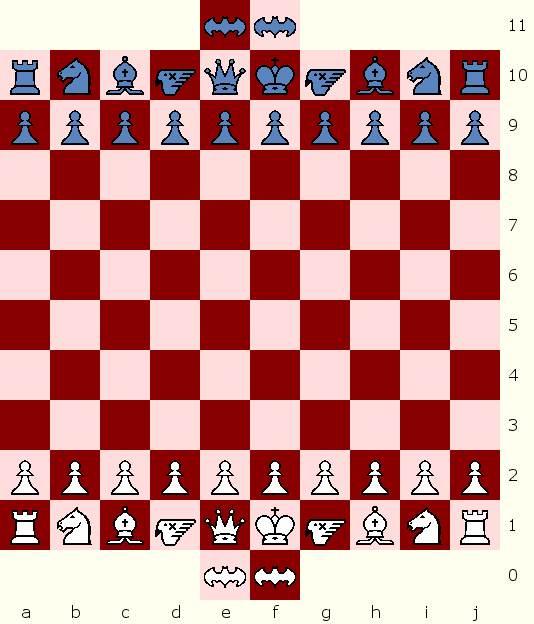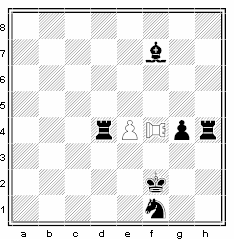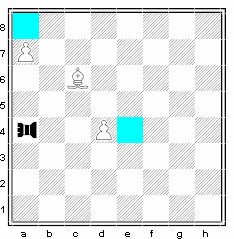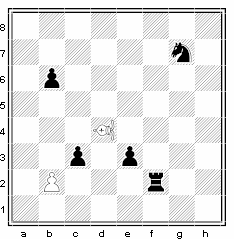Raptor Chess
Derived from the Latin word raptus, meaning "seized" or "one who seizes," Raptor is a general term that categorizes two similar groups of predatory birds.Some dinosaurs are also referred to as raptors.
In fighter plane technology, the Raptor demonstrates extraordinary breakthroughs in maneuverability and stealth.
In Raptor Chess, two pairs of fliers: the Raptors and the Birds each with dual mode movement and capturing abilities compliment each other and create havoc on the board!The Bird (or Flying Bomber) flies orthogonally while the Raptor that flies diagonally.
Each can capture by flying over their victim, and landing on the square right after.
They also possess a unique double capturing ability by combining the fly over capturing mechanism with another mode of capture:
a Helicopter landing capture 2 squares away.
The unique board shape, with two squares protruding from each side's back rank, can kindle a variety of interesting battle plans, while the larger board provides a grand arena for these new unique pieces to battle it out with the other chessmen.
This game was developed from the game Birds and Ninjas, to which it is identical, except that the Raptor, the exact diagonal equivalent to the Bird, replaces the Ninja Guard.
 |
Raptor Chess Main Start position
Coordinates for white. (black mirrors white) Rooks on a1, j1 Knights on b1,i1 Bishops on c1,h1 Raptors on d1, g1 Queen on e1 King on f1 Birds on e0,f0. |
The Bird’s (Flying Bomber’s) Moves
*The flying bomber's shape resembles a bat, hence the iconographic symbols used. However, the flying bomber is also referred to as the "Bird" - a common nickname given to fighter planes. The choice of name is left to the player.
The flying bomber's odd combination of long-range and short-range moves makes it a deadly weapon against an unsuspecting opponent.
Standard Move:- The flying bomber eliminates an enemy piece by flying over it, and landing on THE empty square immediately after it on the same orthogonal line. It cannot fly over or capture a second piece or land on any square beyond the first empty square.
- The flying bomber can fly along any amount of empty squares (1-9) orthogonally, but not over any friendly pieces. This is identical to the movement of a rook.
Special Move: the Helicopter Landing
This is a special maneuver that enables the bird to fly over the adjacent square, (jumping over, if occupied by friendly piece or eliminating if occupied by enemy piece) and land like a helicopter on a square exactly 2 squares away, capturing if possible on this square. It can capture two pieces in this manner.Essentially, it combines its standard move with that of a two space orthogonal jumper.
This peculiar short-range prowess in more detail:
- The Flying Bomber can fly over one friendly piece adjacent to it (left, right, up or down) and land on an empty square immediately after it. When it flies over an adjacent friendly piece, its range is limited to two squares.
- If an enemy piece is exactly 2 squares away orthogonally and no other piece is in-between, then the flying bomber can capture the usual way by flying over it and landing on the empty square after it. It can also capture by landing on the same square as the enemy.
- If two enemy pieces lie on the same line, the first one adjacent to the flying bomber, and the next two squares away, then it can eliminate both pieces by landing on the square of the second enemy piece. (see diagram 1) It cannot fly over the second enemy piece.
- Similarly, if there was a friendly piece in immediate vicinity of the flying bomber, and an enemy piece right after it, then the bird can fly over the friendly piece and destroy the piece right after by landing on the same square. Here too it cannot fly over beyond the enemy piece as it cannot fly over two pieces.
- The Flying Bomber needs at least one square to fly over for a bombing. e.g. it can destroy any enemy piece in its vicinity (1 square to left, right, up or down) by flying over it and landing on the empty square after it, but if a friendly piece occupies a square immediately after the enemy piece, no capture can be made. (see diag 2)
- It must capture the enemy piece it jumps over. (capturing is not optional).
It is easier to remember the flying bomber moves as a combination of the standard move with the move of the Dabbabah - a leaping move two squares in any orthogonal direction.
 diag 1 (sideways rook rep. flying bomber) |
Diag. 1: The flying bomber on f4 is posing multiple threats to black's pieces.
It is threatening to destroy the black bishop on f7 by moving f4-f8. Using its special 2 square helicopter capability, it is threatening the black rook on d4 by moving f4-d4 (flying over its own piece and bombing/landing on d4). It cannot land on any squares beyond d4. This same short-range prowess gives it the ability to threaten f4-h4, flying over and bombing pawn on g4 and landing/bombing rook on h4. Note that the bomber cannot move to g4 by capturing the pawn, it must eliminate both the pawn and the rook. If there was no rook on h4 then the bomber can just capture the pawn by moving f4-h4. Note that the bird IS giving check to the king because it is exactly 2 squares away, and the bird can land on f2. However the bird is not threatening the knight on f1 since it is more than 2 squares away and there is no empty square beyond it. If the king moves, the knight will not be under attack either. |
 diag 2 (sideways rook rep. flying bomber) |
Diag 2: Here the Flying Bomber is hampered by Black’s Pieces.
It is not checking the king at d7 because there is no empty square behind it (and it is not exactly 2 squares away from it). The rook on d8 is pinned, because moving it would enable the king to be captured. However, the king can simply move away and the rook on d8 is not threatened because there is no empty square beyond it. The rook on e4 is adjacent to the flying bomber and threatening it. But the Flying Bomber cannot do anything because the white pawn occupies f4 and the bomber needs an empty square after its target. If f4 was an empty square, the bomber could capture the rook, and if there was another enemy piece on f4 instead of the white pawn, then the bomber could have captured both pieces. The Flying Bomber does attack the pawn on d2. It can fly d4-d1 OR move d4-d2 to eliminate the pawn. Because it is 2 squares away, the bomber can land on the same square as its target. |
 diag 3 (sideways rook rep. flying bomber) |
Diag 3:
Here the black Flying Bomber is threatening white’s pawns at d4 and a7.
However, the white bishop is defending both pawns (colored squares). To make matters worse the bishop is also attacking the bird! |
Diags above shows smaller board than that used for game.
The Raptor's Moves
The Raptor is an exact diagonal version of the Flying Bomber.When not capturing, it moves exactly like the bishop.
To capture, it flies towards its prey along an unobstructed diagonal path and lands on the square immediately after it.
Additionally, like the Flying Bomber, it can make a special move by jumping over a diagonally adjacent friendly piece.
Similarly, it can also capture by landing on the same square as an enemy piece exactly two square away diagonally.
If an empty space separates the Raptor from its prey, then it can capture by replacement on target's square, or if possible, capture by landing on the empty square immediately after.
If there is a friendly piece between the Raptor and its prey, the Raptor can only capture by replacement.
If there is one enemy piece adjacent to it and another immediately after on same diagonal line, the raptor takes out both pieces and lands 2 squares away.
It can also be described as a two step diagonal jumper (the Alfil) combined with the non capturing bishop move, and the diagonal fly over capture mechanism.
 |
The Raptor on d4 can capture pawn on b6 by flying over to
a7 or by flying to b6 (2 square helicopter landing)
It can capture the knight by flying over to h8. It can capture both the pawn and rook by flying over to f2. It cannot fly beyond f2 and it must capture both since it cannot move to e3. The Raptor cannot capture the pawn at c3 since it is blocked by the white pawn at b2. Note that the ninja guard could have captured on c3, as well as on e3, f2, or b6 but it could not have captured the knight at g7. Diag shows smaller board than that used for game. |
Rules
The rules in Raptor Chess are the same as in chess except for the following modifications :-
Castling:
Unlike standard Chess, castling is flexible with the king able to travel 1, 2, 3, or 4 squares towards the rook.
There are 7 possible castling positions, the most extreme wing castling involves the king relocating to the b or i file. The choice of castling positions will depend on whether it is immediately necessary for the king to be tucked away at the wing or for the rook to be centralized.
The usual castling criteria apply: No piece can occupy the spaces travelled by the king and castling rook. Cannot castle out of check. King cannot pass over or land on squares attacked by enemy, but rook can.-
1 space transposition - King Side Castling
White moves King one space from f1-g1 and rook from j1-f1
Black moves King one space from f10-g10 and rook from j10-f10 -
1 space transposition - Queen Side Castling
White moves King one space from f1-e1 and rook from a1-f1
Black moves King one space from f10-e10 and rook from a10-f10 -
2 space transposition - King Side Castling
White moves King two spaces from f1-h1 and rook from j1-g1
Black moves King two spaces from f10-h10 and rook from j10-g10 -
2 space transposition - Queen Side Castling
White moves King two spaces from f1-d1 and rook from a1-e1
Black moves King two spaces from f10-d10 and rook from a10-e10 -
3 space transposition - King Side Castling
White moves King three spaces from f1-i1 and rook from j1-h1
Black moves King three spaces from f10-i10 and rook from j10-h10 -
3 space transposition - Queen Side Castling
White moves King three spaces from f1-c1 and rook from a1-d1
Black moves King three spaces from f10-c10 and rook from a10-d10 -
4 space transposition - Queen Side Castling
White moves King four spaces from f1-b1 and rook from a1-c1
Black moves King four spaces from f10-b10 and rook from a10-c10
-
1 space transposition - King Side Castling
-
Pawn Movement ():
The pawn can move from its original position either 1, 2 or 3 vacant squares forward.
A pawn, which initially moved forward 1 square or captured from its starting position, can subsequently at any time move forward 1 or 2 vacant squares. Once it reaches the center of the board (rank 5 for white, rank 6 for black), it can move forward only one square at a time.
Some examples: the white pawn at f2 can start f2-f5 or it can move f2-f4 then f4-f5, or f2-f3 followed by f3-f5, or move f2-g3 to capture enemy piece at g3 followed by g3-g5 next time it moves. - En Passant: If a Pawn moves two or three squares initially and passes an enemy Pawn on the
4th or 5th rank, it may be captured en passant by the enemy pawn.
E.g. White pawn on a2 black pawn on b4. White pawn moves a2 - a4 (or a5), black pawn on b4 can capture it as if it had moved to a3.
Similarly, black pawn on b5 and white pawn moves a2 - a5, then black pawn can capture the white pawn as if it moved to a4. Note in this case the white pawn can still avoid the black pawn by moving to a3 instead.
If a pawn slides forward 2 squares on its second move, it can also be captured en passant by an opposing pawn on the fifth rank. E.g. white pawn on a3 and black pawn on b5. White plays a3-a5, black pawn on b5 can capture the pawn en passant by moving to a4.
Capturing en passant is optional unless it is the only legal move available. The capture must be made on the next move. - Pawn promotion: Pawns can now promote to: Queen, Bishop, Knight, Rook, Raptor or Bird on the 10th rank only.
Interesting Notes
- Relative Values: It is sometimes hard to gauge the relative values of the pieces. Here is a rough guideline:
Knight=3 pawns
Bishop=4 pawns
Raptor ~ 3-4 pawns
Bird ~ 4 - 5.5 pawns
Rook=6 pawns
Queen=11 pawns. -
Ability to Checkmate:
The raptor alone cannot mate a lone king with the aid of a king, but two opposite colored raptors can. They must utilize
the two square attack mode quite often.
The flying bomber with the aid of the king can checkmate a lone king, but it is very tricky since the king, when at the edge of the board, can often escape. By utilizing the two square attack it is possible to checkmate. - Knight vs Bishop: Because of the larger board, exchanging a bishop for a knight is definitely losing the exchange, though there are cases where the knight is at least as powerful as the bishop.
- King Protection: It may not always be desirable to castle, sometimes the king can have adequate protection in the rear of the palace.
Play the Game!
Play a game of Raptor Chess! (Free Registration at chessvariants.org required).View Game Logs of Raptor Chess
 Download Zillions of Games File
Download Zillions of Games File
|
If you would like to email the chess variant inventor directly: inventor@chess.computerwebservices.net
|
|
Posted by: Good on 2013-01-20 18:09:34 Like Chess: YES Yes, very interesting Posted by: chesster on 2007-12-14 20:31:41 Like Chess: YES
When I saw that other variant Birds and Ninjas, I was wondering how come you didn't think of this one. The Raptor is more complimentary to the Bird than the ninja guard, I thought. So I think this should be better. But really though - there needs to be lot of playtesting to really know. |

